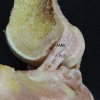Anatomy of the anterior cruciate ligament and the common autograft specimens for anterior cruciate ligament reconstruction
- PMID: 38529244
- PMCID: PMC10929300
- DOI: 10.21037/aoj-22-49
Anatomy of the anterior cruciate ligament and the common autograft specimens for anterior cruciate ligament reconstruction
Abstract
A thorough understanding of the anatomical properties of the native anterior cruciate ligament (ACL), as well as the native specimens that are most commonly considered as viable autograft choices for anterior cruciate ligament reconstruction (ACLR), is warranted for continuing to pursue the best-possible graft choice for patients undergoing ACLR. While a wide variety of graft choices remain available to the operating surgeon, choosing the correct graft choice remains a consideration and discussion with patients on the pros and cons of each option. This article combines a review of the current literature on the quantitative and qualitative anatomy of the native ACL and common autograft specimens with the expert consensus of the senior author on the surgically-pertinent anatomy of these structures. The purpose of this article is to review the anatomy pertaining to the native ACL, along with the distal anatomy of the hamstring tendons, patellar tendon and quadriceps tendon (QT). Multiple tendinous and ligamentous structures exist around the knee that serve as viable candidates for use as autologous grafts for ACLR, and the anatomy of these distal extents of these structures are discussed thoroughly, including bony attachments, quantitative and relational anatomy, cross sectional area, and histological features of these structures.
Keywords: ACL reconstruction; Anatomy; anterior cruciate ligament (ACL); grafts.
2023 Annals of Joint. All rights reserved.
Conflict of interest statement
Conflicts of Interest: All authors have completed the ICMJE uniform disclosure form (available at https://aoj.amegroups.org/article/view/10.21037/aoj-22-49/coif). The series “Implications of Graft Choice in ACL Reconstruction” was commissioned by the editorial office without any funding or sponsorship. NND served as the unpaid Guest Editor for the series. The authors have no other conflicts of interest to declare.
Figures




References
Publication types
LinkOut - more resources
Full Text Sources
Miscellaneous
